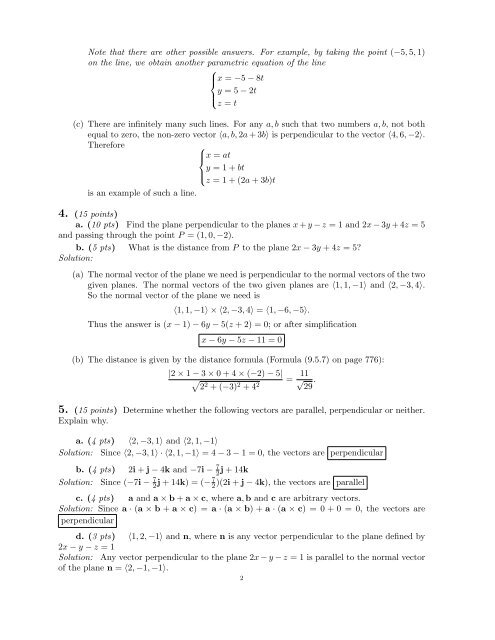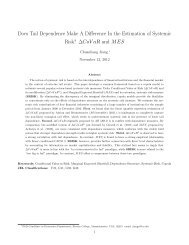MULTIVARIABLE CALCULUS PRACTICE MIDTERM 1 SOLUTIONS
MULTIVARIABLE CALCULUS PRACTICE MIDTERM 1 SOLUTIONS
MULTIVARIABLE CALCULUS PRACTICE MIDTERM 1 SOLUTIONS
You also want an ePaper? Increase the reach of your titles
YUMPU automatically turns print PDFs into web optimized ePapers that Google loves.
Note that there are other possible answers. For example, by taking the point (−5, 5, 1)<br />
on the line, we obtain another parametric equation of the line<br />
⎧<br />
⎪⎨ x = −5 − 8t<br />
y = 5 − 2t<br />
⎪⎩<br />
z = t<br />
(c) There are infinitely many such lines. For any a, b such that two numbers a, b, not both<br />
equal to zero, the non-zero vector 〈a, b, 2a + 3b〉 is perpendicular to the vector 〈4, 6, −2〉.<br />
Therefore<br />
⎧<br />
⎪⎨ x = at<br />
⎪ ⎩<br />
is an example of such a line.<br />
y = 1 + bt<br />
z = 1 + (2a + 3b)t<br />
4. (15 points)<br />
a. (10 pts) Find the plane perpendicular to the planes x + y − z = 1 and 2x − 3y + 4z = 5<br />
and passing through the point P = (1, 0, −2).<br />
b. (5 pts) What is the distance from P to the plane 2x − 3y + 4z = 5<br />
Solution:<br />
(a) The normal vector of the plane we need is perpendicular to the normal vectors of the two<br />
given planes. The normal vectors of the two given planes are 〈1, 1, −1〉 and 〈2, −3, 4〉.<br />
So the normal vector of the plane we need is<br />
〈1, 1, −1〉 × 〈2, −3, 4〉 = 〈1, −6, −5〉.<br />
Thus the answer is (x − 1) − 6y − 5(z + 2) = 0; or after simplification<br />
x − 6y − 5z − 11 = 0<br />
(b) The distance is given by the distance formula (Formula (9.5.7) on page 776):<br />
|2 × 1 − 3 × 0 + 4 × (−2) − 5|<br />
√<br />
2 2 + (−3) 2 + 4 2 = 11 √<br />
29<br />
.<br />
5. (15 points) Determine whether the following vectors are parallel, perpendicular or neither.<br />
Explain why.<br />
a. (4 pts) 〈2, −3, 1〉 and 〈2, 1, −1〉<br />
Solution: Since 〈2, −3, 1〉 · 〈2, 1, −1〉 = 4 − 3 − 1 = 0, the vectors are perpendicular<br />
b. (4 pts) 2i + j − 4k and −7i − 7 2 j + 14k<br />
Solution: Since (−7i − 7 2 j + 14k) = (− 7 2<br />
)(2i + j − 4k), the vectors are parallel<br />
c. (4 pts) a and a × b + a × c, where a, b and c are arbitrary vectors.<br />
Solution: Since a · (a × b + a × c) = a · (a × b) + a · (a × c) = 0 + 0 = 0, the vectors are<br />
perpendicular<br />
d. (3 pts) 〈1, 2, −1〉 and n, where n is any vector perpendicular to the plane defined by<br />
2x − y − z = 1<br />
Solution: Any vector perpendicular to the plane 2x − y − z = 1 is parallel to the normal vector<br />
of the plane n = 〈2, −1, −1〉.<br />
2
















